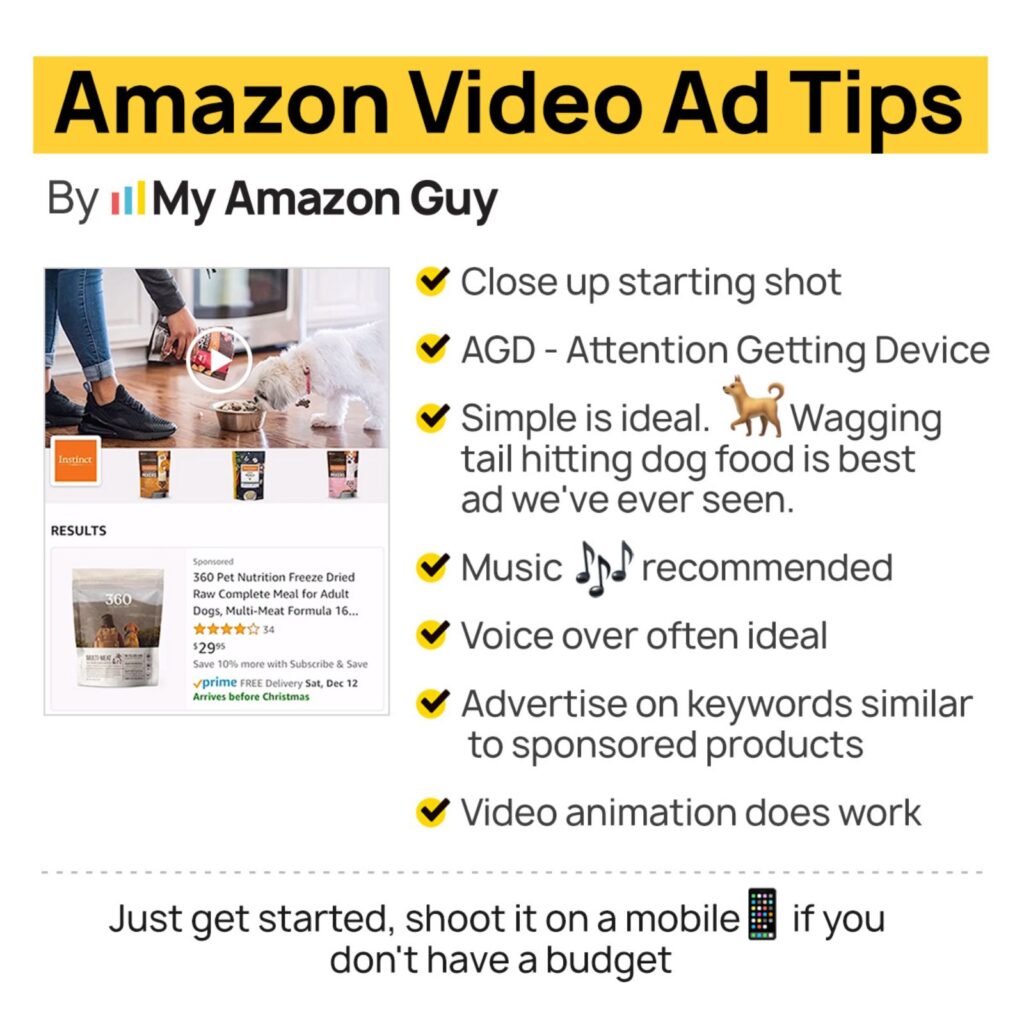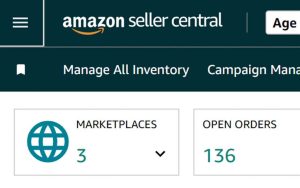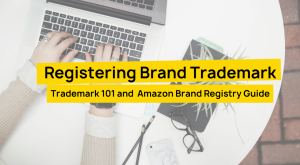Last Updated: August 1, 2025
Stop flailing around and sell stuff with an effective Amazon marketing strategy. This isn’t the time to throw money at ads and hope for the best; it’s time to get strategic.
Alright, sellers, here’s the problem: You’ve got a solid product, but with more than 600 million listings on Amazon, it’s invisible without the right moves.
Without a clear marketing strategy, you’re gambling with your business. Wishing for sales is not a strategy because execution is what wins in 2025.
This article breaks down proven Amazon marketing strategies to help sellers boost visibility, drive traffic, and increase sales in 2025 and beyond. It covers key areas like PPC, SEO, branding, and off-Amazon tactics to build a strong, data-driven marketing plan.
Table of Contents
Struggling to Stand Out on Amazon?
We help sellers like you market smarter, rank higher, and scale faster.
10 Amazon Marketing Strategies You Need to Win in 2025
Because of how massive and competitive Amazon has become, it’s no surprise that around 9.7 million sellers are on the platform. But with how saturated every category is, it can be difficult to stand out without a solid Amazon marketing strategy.
1. Develop Your Branding
Branding is how you show shoppers you’re serious since it builds credibility and makes your Amazon store look professional. A clear and consistent brand helps you stand out, get remembered, and turn buyers into loyal fans.
A. Understand Your Long-Term Goals
Knowing where you want your brand to go makes a huge difference in how you shape it today. You can build stronger branding by setting clear, realistic goals that align with the future you’re aiming for.
B. Identify Strengths and Weaknesses
Knowing what your brand does well helps you stand out, while recognizing your weak points keeps your messaging tight and consistent. Use your strengths to build a competitive edge and fix gaps that could confuse or turn off customers.
C. Determine Your Unique Selling Proposition (USP)
When you know exactly what makes your brand different, it’s easier to market your products with confidence and clarity. Your USP helps you highlight the specific value you offer that competitors don’t.
D. Create a Distinct Brand Identity
Having a distinct brand identity is key to marketing your products effectively and making a lasting impression on customers. Here are a few core elements you can work on to build a strong, memorable brand:
- Logo: Design a unique and recognizable logo.
- Colors: Choose a color palette that represents your brand’s personality.
- Fonts: Select fonts that are consistent with your brand’s image.
- Messaging: Craft clear and compelling messages that resonate with your audience.
- Tone of Voice: Maintain a consistent tone in all communications.
- Brand Values: Define and communicate your core values.
E. Implement Branding Across All Marketing Channels
Consistency is what makes your brand stick, so your branding needs to show up the same way across every touchpoint. That includes your Amazon listings, social media, website, packaging, customer service, and promos.
F. Foster Brand Recognition
Brand recognition doesn’t happen overnight because it’s built through repeated, consistent exposure that sticks in your customer’s mind. Focus on increasing your brand’s visibility wherever your audience spends time, so they instantly associate your name with what you sell.
G. Establish Credibility & Trust
Establishing trust is non-negotiable if you want customers to keep coming back. Back up your claims with real results, authentic interactions, and consistent delivery on what your brand promises.
2. Identify & Understand Your Target Audience
Identifying and understanding your target audience is the backbone of any successful Amazon marketing strategy since it tells you exactly who you’re selling to and why they should care. When you know your ideal customer, you can run laser-focused campaigns, increase customer satisfaction, and spend your marketing dollars where they count.
A. Conduct Research
Researching your target audience helps you make informed decisions and craft marketing strategies that connect. Below are key areas to focus on when researching your ideal customer:
- Demographics: Gather data on age, gender, income level, education, and location.
- Psychographics: Know your audience’s interests, values, lifestyle, and personality traits.
- Behaviors: Analyze purchasing habits, brand interactions, and product usage.
B. Analyze Data
Analyzing data is key to spotting patterns and truly understanding what drives your target audience. You can do this by using tools like customer surveys, social media insights, and industry reports to dig deeper into their behaviors and preferences.
C. Create Customer Avatar
Creating a customer avatar helps you narrow down exactly who you’re selling to, making it easier to tailor your Amazon marketing strategy. To create a customer avatar:
- Start with your product and target audience (initial guess).
- Look at sales data and real-world observations to see who buys your product.
- Focus on the benefits your product offers and tailor your avatar to someone who would use it.
- The level of detail can vary depending on how specific your product is.
D. Segment Your Audience
Segmenting your audience is a smart way to personalize your messaging and make your marketing more efficient. You can do this by grouping customers based on shared traits like demographics, buying behavior, or product preferences.
E. Utilize Targeted Advertising
Targeted advertising is how you put your audience research into action to drive real results. You can use the data and customer segments you’ve identified to create Amazon ad campaigns that speak directly to each group’s specific needs and interests.
F. Customize Marketing Efforts
Customizing your marketing efforts ensures your message connects with the people you’re trying to reach. By aligning your strategy with each segment’s needs, preferences, and pain points, you can create more relevant and persuasive campaigns.
3. Craft Your Value Proposition
Creating a strong value proposition is a key part of building an effective Amazon marketing strategy because it’s how you position your product to win attention and trust. It tells potential customers exactly why your product is different, better, and worth buying.
A. Define the Specific Need
Defining the specific need is the first step to creating a strong value proposition because it helps clarify the exact problem your product solves. Focus on what your target audience is actively looking for in a solution so your messaging hits the mark.
B. Highlight Additional Benefits
Highlighting additional benefits strengthens your value proposition by showing how your product goes beyond just solving the core problem. Point out unique features or extras that meet secondary needs or add more value to the main solution.
C. Compare with Competitors
Comparing your product with competitors helps you position it as the better choice. Look for weaknesses or missing features in competing products and show how yours fills those gaps.
D. Formulate the Value Proposition
Formulating your value proposition brings everything together into a clear and compelling message. Use language your audience relates to and focus on how your product meets their needs better than the alternatives.
E. Test and Refine
Testing and refining your value proposition helps ensure it connects with your audience. Use customer feedback to fine-tune your messaging so it stays relevant, sharp, and persuasive over time.
F. Communicate Consistently
Consistent communication of your value proposition builds trust and reinforces your brand message. Make sure it’s clearly reflected across your listings, ads, and every customer touchpoint.
G. Sample Value Proposition Templates
Having a few go-to templates can make writing your value proposition easier and more focused. Use these examples to plug in your product’s strengths and communicate your edge clearly and effectively:
- “Our product solves [specific problem] by [how it solves the problem].”
- “Unlike other products, it offers [unique feature] and [additional benefit].”
- “This means customers get [primary benefit] plus [extra advantage], making it the best choice over [competitor].”
To learn about standing out in the vast Amazon marketplace, here is a post you can read: Why Product Differentiation is Important to Make It Big on Amazon
4. Price Your Product
93% of shoppers compare prices online before buying, which makes pricing a critical part of your Amazon marketing strategy. How you price your product can impact visibility, conversions, and long-term profitability.
A. Understand Customer Willingness to Pay
To price your product effectively, you need to know what your target audience is willing to pay. Use customer feedback, competitor pricing, and market research tools to find that sweet spot where perceived value meets realistic spending behavior.
B. Calculate Costs and Markups
You can’t price smart without knowing the full costs of your product, shipping, Amazon fees, and overhead. Once you’ve nailed that down, set a markup that keeps your margins healthy while still being competitive.
C. Establish Profit Margins
Profit margins aren’t just numbers because they determine how sustainable your Amazon business is. Aim for pricing that keeps your product attractive while hitting the margin targets you need to grow.
D. Choose Payment Methods
Giving customers flexibility at checkout can directly impact conversion rates. Offering multiple payment methods, like credit cards, Amazon Pay, or Buy Now, Pay Later, makes purchasing easier and more appealing, but be mindful of processing fees that cut into your bottom line.
E. Factor in Additional Costs
A competitive price means nothing if it eats up your margins. Always factor in Amazon referral fees, FBA or FBM fulfillment charges, ad spend, packaging, and customer support costs because those “hidden expenses” can quietly drain your profits.
F. Implement Discount Strategies
Discounts are about driving demand when it matters most. Strategic markdowns during seasonal spikes, email-only promotions, or loyalty perks through subscriptions can boost conversions without tanking your margins.
G. Pricing Strategy To Make A New Product A Best Seller
Temporarily lowering your price by up to 50% can help generate early sales and reviews, which are key to building momentum. Once traction is established, gradually raise the price to recover profits while maintaining your ranking.
5. Invest in Amazon SEO
Amazon SEO is how your product gets found, ranked, and clicked on. By targeting the right keywords and optimizing every inch of your listing, you’ll increase visibility, outperform competitors, and drive long-term sales growth.
A. Utilize AI Tools for Product Copy
AI tools can speed up listing creation and improve SEO when used strategically. The key is to guide them with strong keyword data so the output supports better indexing and conversion.
B. Implement the MAG SEO Phase Process
There are plenty of SEO tactics floating around, but our Amazon agency follows a proven SEO phase strategy that delivers consistent results. Below are the four steps that guide how we rank and optimize listings effectively:
- Phase 1 – Optimization: Use primary keywords in titles and backend search terms.
- Phase 2 – Indexing: Adjust search terms and keywords based on performance.
- Phase 3 – Ranking: Focus on “Strike Zone” keywords (rank 20-50) to push them higher.
- Phase 4 – Analysis: Utilize Search Query Performance reports to refine strategies.
C. Optimize Your Product Listing
Part of Amazon SEO is making sure your product listing is fully optimized to improve visibility and conversions. You can optimize your listings by doing the following:
- Titles: Include primary keywords, brand name, and key benefits.
- Bullet Points: Answer FAQs, mention warranty, and keep it short.
- Main Image: Add primary keywords directly into the image using our CTR Hack.
- Secondary Images: Use infographics and lifestyle shots to highlight features.
- Product Description: Generate with AI, edit for clarity, and add keywords.
- A+ Content: Add alt text and backend keywords for extra indexing.
6. Promote Your Products
Product promotion is an investment in its discoverability, sales potential, and overall success within the platform. It’s a powerful tool to reach your target audience, build brand recognition, and ultimately turn casual browsers into loyal customers.
A. Use Amazon Advertising
Running Amazon ads is essential to driving traffic and boosting visibility for your listings. Start with PPC campaigns targeting mid-traffic keywords, monitor ACoS closely, and use Sponsored Product, Brand, and Display Ads within your budget.
B. Offer Discounts and Promotions
Offering smart discounts and promos can boost traffic, sales velocity, and early reviews. Use limited-time offers, strategic early discounts, and Amazon events like Prime Day to stay competitive without killing your margins.
C. Utilize Email Marketing
Email marketing is still one of the most effective ways to drive repeat purchases and build customer relationships, since 59% of shoppers say emails influence their buying decisions. Use it to send follow-ups that encourage reviews and keep your brand top of mind.
D. Use Affiliate Marketing
Affiliate marketing helps drive external traffic and build brand awareness. Join the Amazon Associates Program and reward affiliates with commission-based sales using trackable links across their platforms.
7. Utilize Multichannel Marketing For Your Marketing Plan
Multichannel marketing helps you reach more potential buyers by showing up where they already are, like social media, email, Amazon, and beyond. It builds stronger brand recognition, deeper engagement, and more conversions through a consistent presence across platforms.
A. Influencer Marketing
Influencer marketing helps build trust and awareness fast, especially for premium products. When you collaborate with the right creators, you tap into loyal, targeted audiences ready to buy.
B. User-Generated Content (UGC)
User-generated content builds trust and drives off-Amazon traffic even without attribution links. Real customers sharing their experience is more convincing than any ad you’ll ever run.
C. Social Media Marketing
Social media helps boost visibility and drive interest back to your Amazon listings. You can do this across platforms like Facebook, Instagram, LinkedIn, TikTok, and more to reach different audiences and influence buying decisions.
8. Use Video Marketing
73% of U.S. shoppers are more likely to buy after watching a product video. That makes video marketing a powerful tool to increase conversions and build trust with potential buyers.
A. Incorporate Video Marketing on Amazon
There are various types of videos you can create to market your products directly on Amazon, each serving a specific purpose in the customer journey. Here are the most effective types you should consider:
Product Demos and Tutorials in Digital Marketing
Showcase Features: Demonstrate how your product works, its benefits, and what makes it different.
Educational Content: Use tutorials to walk customers through usage, setup, or care to reduce confusion and returns.
Customer Testimonials and Reviews
Build Trust: Feature real customers sharing their honest feedback to boost credibility.
Showcase User Experience: Let shoppers see how your product fits into real-life scenarios and solves problems.
Behind-the-Scenes and Brand Storytelling
Brand Narrative: Share your origin, mission, and values to connect with shoppers on a personal level.
Show Transparency: Offer behind-the-scenes footage of your team or production process to build trust.
FAQs and Customer Support
Answer Queries: Use video to respond to commonly asked questions before a customer even asks.
Improve Customer Experience: Clear visual explanations reduce support tickets and improve satisfaction.
Social Proof and Influencer Collaborations
Influencer Endorsements: Have influencers demonstrate your product on video to increase exposure and validation.
9. Set Up A Dedicated Website
One powerful way to market your brand beyond Amazon is by launching your own DTC site. With the rise of platforms like Shopify, having a dedicated website has become a popular strategy for brands to gain control, collect customer data, and expand sales channels.
Tips for Launching a Dedicated Website
Building your own DTC website can feel overwhelming, but it’s a key move toward long-term brand control and growth. Here are tips to help you create a site that drives traffic, builds trust, and converts:
- Choose the Right Platform: Select a platform that integrates with Amazon, such as Shopify or WooCommerce.
- Keep It Simple: Don’t overwhelm customers with too much information. Keep your website design clean and easy to navigate.
- Optimize for SEO: Ensure your website is optimized for search engines to improve visibility and drive organic traffic.
- Integrate with Amazon: Integrate your website with Amazon to leverage your customer reviews and ratings.
10. Measure Your Marketing Performance
Tracking key metrics like sales, traffic, conversions, and customer engagement is essential to understanding what’s working. Use analytics tools to make smarter decisions, boost ROI, and scale your Amazon strategy with confidence.
A. Key Metrics for Measurement
Understanding which numbers to watch can make or break your marketing efforts on Amazon. Here are the key metrics that give you a clear picture of how your listings, ads, and customer interactions are performing.
Sales Metrics
- Total Sales: Monitor overall revenue generated from Amazon sales.
- Sales Growth: Track trends in sales growth over specific periods.
Traffic Metrics
- Sessions: Measure the number of visits to your Amazon product pages.
- Traffic Sources: Identify the origin of your traffic, such as organic search or paid Amazon ads.
Conversion Metrics
- Conversion Rate: Calculate the percentage of visitors who complete a purchase.
- Add-to-Cart Rate: Measure how frequently shoppers add your products to their cart.
Advertising Performance
- ACoS (Advertising Cost of Sales): Assess the efficiency of Amazon PPC campaigns.
- CTR (Click-Through Rate): Evaluate the effectiveness of your ad creative and placement.
Customer Engagement
- Reviews and Ratings: Monitor customer feedback and ratings to gauge satisfaction.
- Question & Answer Activity: Track engagement and responsiveness to customer inquiries.
B. Tools and Methods for Measurement
To track what’s working and what’s not, you need the right tools. Below are some reliable options to help you measure performance both on and off Amazon.
- Amazon Seller Central Analytics: Use integrated tools for detailed insights into sales, traffic, and customer behavior.
- Google Analytics: Integrate tracking pixels with Amazon to measure external traffic and conversions.
- Third-party Analytics Tools: Employ advanced analytics tools like Jungle Scout for competitor analysis.
C. Steps to Measure Performance
Measuring performance is about using it to guide smart decisions. Follow these key steps to turn raw data into actionable insights that improve your Amazon strategy.
- Set Clear Objectives: Set specific goals like sales targets, ROI, or traffic growth.
- Track KPIs Regularly: Monitor your metrics daily, weekly, and monthly.
- Compare Against Benchmarks: Check performance against past data and industry standards.
- Optimize Based on Insights: Use your data to improve ads, listings, and strategy.
- Report and Iterate: Share reports, learn from results, and keep refining your approach.
Your Products Deserve More Visibility
Let us help you create a marketing strategy that gets you noticed and gets you results.
Amazon Marketing Mistakes Sellers Should Avoid
Learning about the common mistakes that sellers make when launching a product is one of the smartest strategies you can use. It helps you avoid disaster before it even begins, so here are five of the worst marketing mistakes you need to steer clear of:
1. Not Optimizing Product Listings
Weak images, vague descriptions, and missing keywords kill your visibility and conversion rates. Every listing should be optimized with high-quality images, keyword-rich copy, and clear product benefits.
2. Running Ineffective PPC Campaigns
Launching ads without proper keyword research or bid management drains your ad budget fast. Structure your campaigns with clear goals, use negative keywords, and monitor results often.
3. Pricing Without a Strategy
Setting prices too high or too low without checking your competition can wreck your sales. Stay competitive by reviewing market prices and adjusting based on demand and performance data.
4. Relying on One Marketing Channel
Putting all your eggs in one marketing basket makes your sales fragile. Build a broader presence by using social media, email marketing, influencers, and Amazon’s internal tools.
5. Neglecting Branding
Sellers who skip branding blend into the crowd and struggle to build customer loyalty. Build a clear brand identity with consistent visuals, messaging, and packaging that sets you apart from competitors.
FAQs About Amazon Marketing Strategies
How much does it cost to advertise on Amazon?
Amazon advertising works on a pay-per-click model, so you only pay when someone clicks your ad. Most sellers spend anywhere from $0.20 to $3.00 per click, depending on the category and competition.
What are the 4 P's of marketing on Amazon?
The 4 P’s are Product, Price, Promotion, and Placement. On Amazon, this means having a great product, competitive pricing, strong advertising, and strategic positioning through SEO and keyword targeting.
What is Amazon’s A10 algorithm?
The A10 algorithm powers Amazon's search ranking system and impacts how products show up in search results. To work with it, not against it, sellers need solid marketing strategies like organic keyword targeting, strong product listings, and driving external traffic to boost relevancy, trust signals, and long-term visibility.
Take Control of Your Amazon Marketing
With the ever-evolving landscape of Amazon marketing, it’s essential to stay ahead of the game by building a strategy that drives sales, builds brand awareness, and earns customer trust. A well-rounded 2025 marketing plan is a must if you want to stay competitive.
By following the strategies outlined in this article, you’ll be well on your way to launching a campaign that actually works. Remember, hoping for sales won’t cut it, so put in the work, stay consistent, and turn your Amazon marketing strategy into real results.
Ready to take your Amazon business to the next level? Contact our full-service Amazon agency today for a consultation and discover how our proven methods can transform your sales trajectory.
Need Help With Your Amazon Marketing Strategy?
Let our experts guide you in building a data-driven plan that actually grows your sales.





